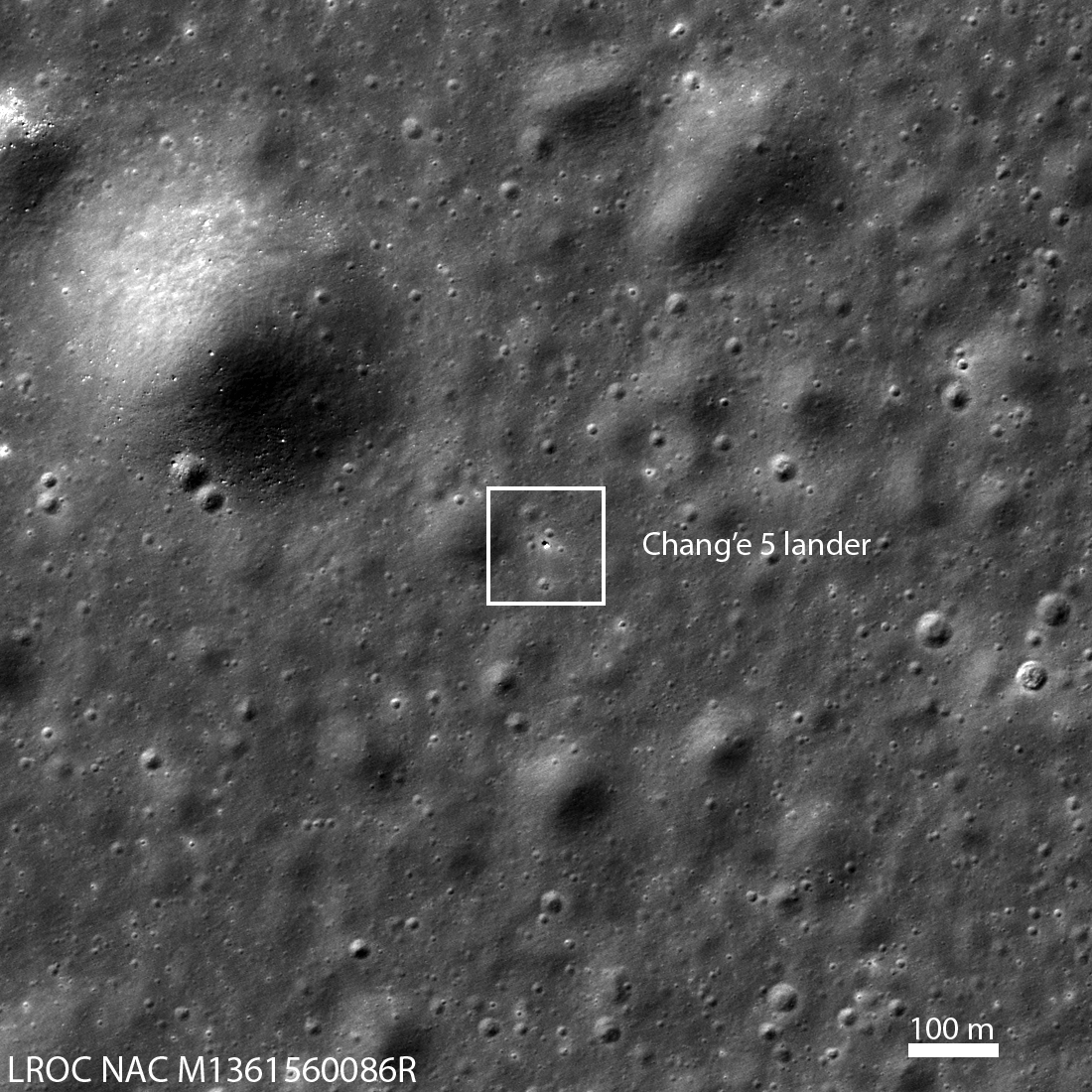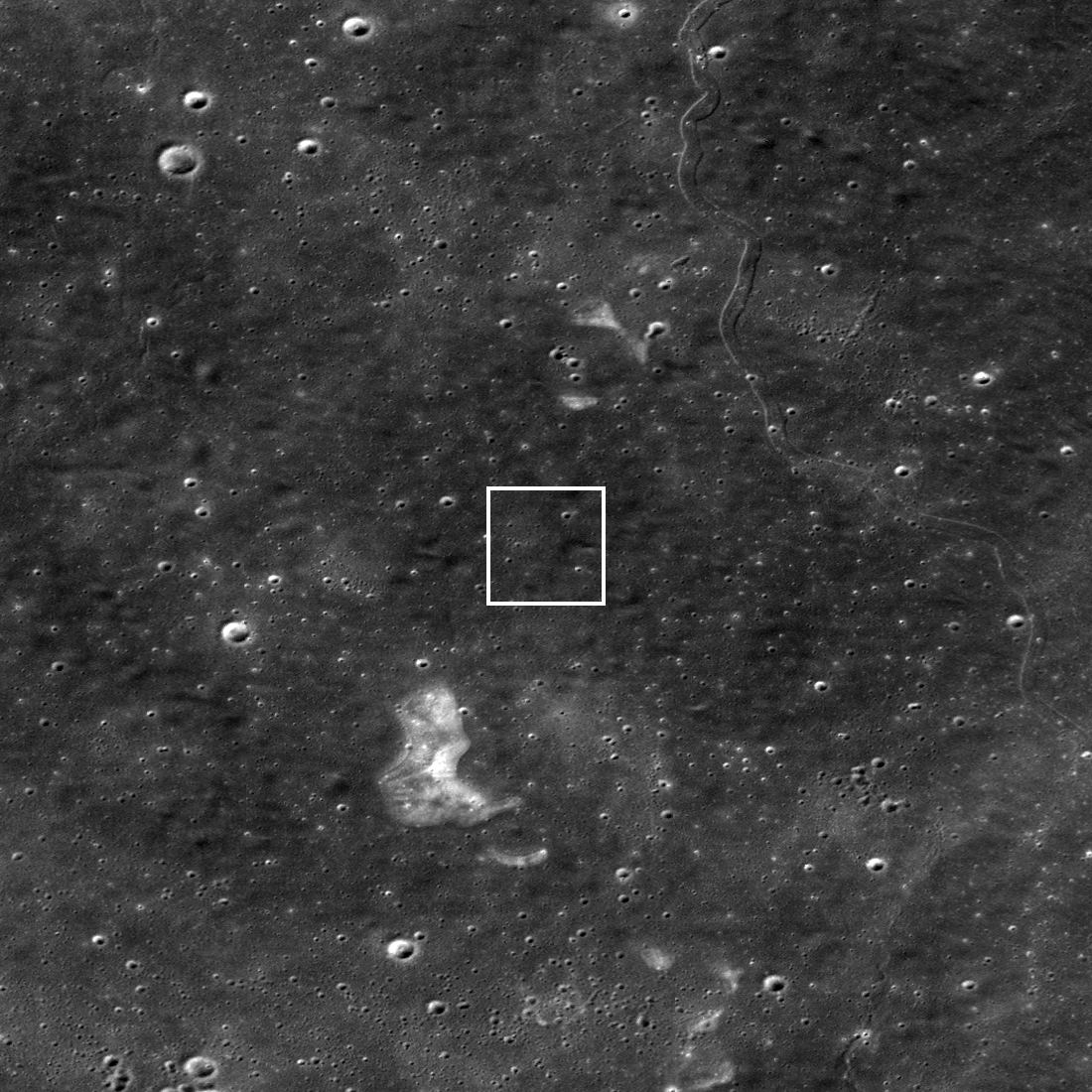On Tuesday, December 1st, at 10:11 EST (07:00 PST) the Chang’e-5 sample return spacecraft landed safely on the Moon. This mission is the latest in China’s lunar exploration program, which is paving the way for the creation of a lunar outpost and a crewed mission by the 2030s. The day after it landed, the Lunar Reconnaissance Orbiter (LRO) passed over the site and acquired an image of the lander.
The images above and below were captured by the LRO’s Wide Angle Camera and show the Chang’e-5 lander’s location in a white box – the lander is represented by a white dot. These showcase the Oceanus Procellarum (“Ocean of Storms”), a large lunar mare located at the western edge of the near side of the Moon. Due to its size, measuring 2,500 km (1,600 mi) from north to south, it is the only mare to be designated “Oceanus.”

Like all lunar maria, Oceanus Procellarum is a basaltic plain that was formed when highly-fluid but thick lava flows covered the region. This is similar to flood basalts on Earth, where lava flows expand to become nearly flat as they solidify, but retain features that are indicative of their volcanic origin. But unlike lava flows that are studied on Earth, Oceanus Procellarum was formed between 1 and 2 billion years ago.
What’s more, these samples could be billions of years younger than anything collected by the Apollo astronauts or Soviet Luna missions so far. These could therefore shed light on the Moon’s geological history and interior. While the Moon is geologically inactive today, scientists know that the situation was different in the past. Not only did the Moon have active volcanoes, but it’s also even believed to have had a lunar magnetic field.
In the image above, which covers a region measuring 61 km (38 mi) in diameter, a channel feature is visible. This corresponds to a winding narrow channel (aka. rille), which was formed by a volcanic eruption more than a billion years ago. The bright area to the south is a massif of older terrain protruding through the basaltic layer of the mare.

In the second annotated image (directly above), the focus is on a much smaller region that measures 1210 m (3970 ft) in diameter. In this image, the craters that form a triangle-like formation around the lander are more visible. Once again, the lander’s location is indicated by a white box while the lander is a white dot in the center.
On Dec. 16th, the Chang’e-5 lander returned its samples to Earth via a 300 kg (~660 lbs) return capsule. This capsule, which contained 2 kg (4.4 lbs) of drilled and scooped lunar material, landed in Inner Mongolia at 12:59 P.M. EST (09:59 A.M. PST). The recovery of this sample marks the end of the Chang’e-5 mission and Phase III of the Chinese Lunar Exploration Program.
Phase IV, which will entail the construction of a lunar outpost, is expected to begin in 2023-2024 with the launch of the Chang’e-6 and Chang’e-7 missions. If all goes well, China plans to send its first crewed mission to the southern polar region of the Moon by the 2030s.


My browser didn’t mount the images, and opening their address in a separate tab returned an invalid (unsafe) certificate complaint.
Clicking through that by selection “Advanced” et cetera and then reloading this page works.
My browser didn’t mount the images, and opening their address in a separate tab returned an invalid (unsafe) certificate complaint.
Clicking through that by selecting “Advanced” et cetera and then reloading this page works.
Double comment because the site connection intermittently broke.
The two images can be found here.
http://lroc.sese.asu.edu/ckeditor_assets/pictures/973/content_change5.vis.crop.wac_box.png
http://lroc.sese.asu.edu/ckeditor_assets/pictures/974/content_CE5_1100p_Image_version2.png
Alternatively the original LROC page is here.
http://lroc.sese.asu.edu/posts/1172